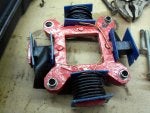Back about 2007 I purchased a Bolens 1050 tractor that had a small Honda manual start engine installed on it. The original Wisconsin engine had a broken camshaft along with other problems and was included in the deal as a basket case. The Honda engine installation was not very well done and since it left the 1050 underpowered at around 6 HP - the original Wisconsin was rated at about 10.5 HP. I priced out repairing the Wisconsin and decided that I could purchase a brand new Honda GX390 engine with electric start for less money which I did. I relocated the air filter and created a new exhaust pipe which allowed me to install the engine without cutting the hood and things moved ahead nicely and after about a month I had the engine installed and running. It gets used regularly and I have found the Honda GX390 to be a good reliable engine over the years. One thing that I did not give much thought to initially when I purchased the engine was the output rating of the charging system since it had electric start. What I found out after I got the engine mounted was that the model I had purchased only had a 3 amp charge coil and did not utilize a true voltage regulator / rectifier that one would normally find on higher output charge systems. Instead the 3 amp coil output was fed into a diode and designed to provide a D.C. trickle charge to maintain a battery for starting. As a result the electrical load required to run two sealed beam headlamps and a taillamp left the ammeter showing a discharge whenever the lights were switched on. I had priced purchasing a 10 amp or 18 amp charge coil set up along with a Honda voltage regulator and the price was more than I wished to spend so I opted for an alternative. I came up with a plan and initially made a 4 pole stator (patterned after the 18 amp stator) out of some metal plates and wound the poles with 16 gauge magnet wire along with a full wave rectifier / regulator that was rated for 15 amps and my home brew system provided approximately 8 amps of current which was adequate to maintain the battery with the lights on. This worked well for about a year and then the stator developed a short in one of the windings - probably caused by excessive eddy currents which create heat since the metal plates I used were thicker than a normal stator laminated set up.
Attached are pictures of the original 3 amp charge coil and a picture I took of the first stator I made. Back then I was not much for taking pictures and documenting things so I am going off memory for the most part.
![]()
![]()
Attached are pictures of the original 3 amp charge coil and a picture I took of the first stator I made. Back then I was not much for taking pictures and documenting things so I am going off memory for the most part.






